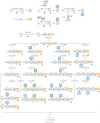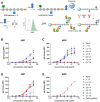(Automated) Synthesis of Well-defined Staphylococcus Aureus Wall Teichoic Acid Fragments
- PMID: 33991006
- PMCID: PMC8361686
- DOI: 10.1002/chem.202101242
(Automated) Synthesis of Well-defined Staphylococcus Aureus Wall Teichoic Acid Fragments
Abstract
Wall teichoic acids (WTAs) are important components of the cell wall of the opportunistic Gram-positive bacterium Staphylococcus aureus. WTAs are composed of repeating ribitol phosphate (RboP) residues that are decorated with d-alanine and N-acetyl-d-glucosamine (GlcNAc) modifications, in a seemingly random manner. These WTA-modifications play an important role in shaping the interactions of WTA with the host immune system. Due to the structural heterogeneity of WTAs, it is impossible to isolate pure and well-defined WTA molecules from bacterial sources. Therefore, here synthetic chemistry to assemble a broad library of WTA-fragments, incorporating all possible glycosylation modifications (α-GlcNAc at the RboP C4; β-GlcNAc at the RboP C4; β-GlcNAc at the RboP C3) described for S. aureus WTAs, is reported. DNA-type chemistry, employing ribitol phosphoramidite building blocks, protected with a dimethoxy trityl group, was used to efficiently generate a library of WTA-hexamers. Automated solid phase syntheses were used to assemble a WTA-dodecamer and glycosylated WTA-hexamer. The synthetic fragments have been fully characterized and diagnostic signals were identified to discriminate the different glycosylation patterns. The different glycosylated WTA-fragments were used to probe binding of monoclonal antibodies using WTA-functionalized magnetic beads, revealing the binding specificity of these WTA-specific antibodies and the importance of the specific location of the GlcNAc modifications on the WTA-chains.
Keywords: antibodies; automated synthesis; gram-positive bacteria; ribitol phosphate; wall teichoic acids.
© 2021 The Authors. Chemistry - A European Journal published by Wiley-VCH GmbH.
Conflict of interest statement
The authors declare no conflict of interest.
Figures







Similar articles
-
Surface Glycopolymers Are Crucial for In Vitro Anti-Wall Teichoic Acid IgG-Mediated Complement Activation and Opsonophagocytosis of Staphylococcus aureus.Infect Immun. 2015 Nov;83(11):4247-55. doi: 10.1128/IAI.00767-15. Epub 2015 Aug 17. Infect Immun. 2015. PMID: 26283333 Free PMC article.
-
Glycosylation of Staphylococcus aureus cell wall teichoic acid is influenced by environmental conditions.Sci Rep. 2019 Mar 1;9(1):3212. doi: 10.1038/s41598-019-39929-1. Sci Rep. 2019. PMID: 30824758 Free PMC article.
-
Genetic diversity of Staphylococcus aureus wall teichoic acid glycosyltransferases affects immune recognition.Microb Genom. 2022 Dec;8(12):mgen000902. doi: 10.1099/mgen.0.000902. Microb Genom. 2022. PMID: 36748528 Free PMC article.
-
Pathways and roles of wall teichoic acid glycosylation in Staphylococcus aureus.Int J Med Microbiol. 2014 May;304(3-4):215-21. doi: 10.1016/j.ijmm.2013.10.009. Epub 2013 Nov 1. Int J Med Microbiol. 2014. PMID: 24365646 Review.
-
The staphylococcal surface-glycopolymer wall teichoic acid (WTA) is crucial for complement activation and immunological defense against Staphylococcus aureus infection.Immunobiology. 2016 Oct;221(10):1091-101. doi: 10.1016/j.imbio.2016.06.003. Epub 2016 Jun 15. Immunobiology. 2016. PMID: 27424796 Review.
Cited by
-
Invasive Staphylococcus epidermidis uses a unique processive wall teichoic acid glycosyltransferase to evade immune recognition.Sci Adv. 2023 Nov 24;9(47):eadj2641. doi: 10.1126/sciadv.adj2641. Epub 2023 Nov 24. Sci Adv. 2023. PMID: 38000019 Free PMC article.
-
Glycan-specific IgM is critical for human immunity to Staphylococcus aureus.Cell Rep Med. 2024 Sep 17;5(9):101734. doi: 10.1016/j.xcrm.2024.101734. Cell Rep Med. 2024. PMID: 39293400 Free PMC article.
-
Antibody Recognition of Different Staphylococcus aureus Wall Teichoic Acid Glycoforms.ACS Cent Sci. 2022 Oct 26;8(10):1383-1392. doi: 10.1021/acscentsci.2c00125. Epub 2022 Aug 17. ACS Cent Sci. 2022. PMID: 36313161 Free PMC article.
-
Epitope Recognition of a Monoclonal Antibody Raised against a Synthetic Glycerol Phosphate Based Teichoic Acid.ACS Chem Biol. 2021 Aug 20;16(8):1344-1349. doi: 10.1021/acschembio.1c00422. Epub 2021 Jul 13. ACS Chem Biol. 2021. PMID: 34255482 Free PMC article.
-
Synthetic Glycans to Improve Current Glycoconjugate Vaccines and Fight Antimicrobial Resistance.Chem Rev. 2022 Oct 26;122(20):15672-15716. doi: 10.1021/acs.chemrev.2c00021. Epub 2022 May 24. Chem Rev. 2022. PMID: 35608633 Free PMC article. Review.
References
-
- Lowy F. D., N. Engl. J. Med. 1998, 339, 520. - PubMed
-
- None
-
- A. Fattom, (Nabi Biopharmaceuticals), WO 2007/053176 A2, 2007;
MeSH terms
Substances
Grants and funding
LinkOut - more resources
Full Text Sources
Other Literature Sources
Medical
Miscellaneous

